A newcomer to Marshall’s catalogue, the Middleton is at the top of the portable range, in addition to the Marshall Willen and Marshall Emberton II. Larger, more expensive, the Middleton inherits the acoustic solutions of the manufacturer’s residential speakers, in this case the use of tweeters to refine the reproduction of high frequencies, as well as bi-amplification to play louder. As the sunny days are looming, the Marshall Middleton intends to compete with the Sony SRS-XG300 and JBL Xtreme 3 in the game of the best Bluetooth speaker to take to the grass or to the water’s edge.
Marshall MiddletonTechnical sheet
9 /10

This test was carried out with a loudspeaker lent by the manufacturer.
Marshall MiddletonDesign
Recognizable at first glance, the Marshall Middleton is dressed in the finery specific to the manufacturer’s speakers. There’s the wide front grille, with the typical metal mesh, flanked by the gold Marshall logo. The Middleton is covered with a carbon black silicone envelope, as elegant as it is practical since it absorbs shocks during handling and prevents the transmission of vibrations from the speaker to the surface on which it is located.
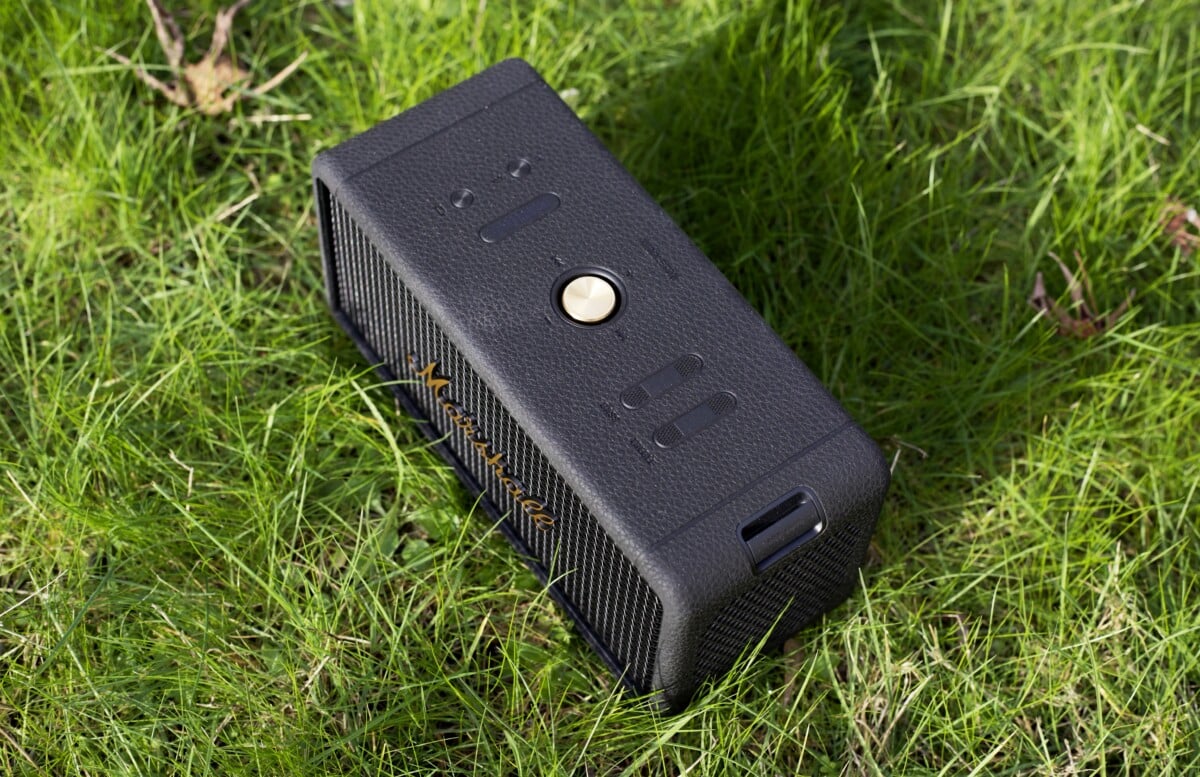
The control buttons are installed at the top and, for the most part, hidden under the silicone casing. On the left are the Bluetooth pairing and battery status buttons, while on the right are the tone (bass/treble) buttons. In the center sits a golden aluminum navigation button, brass-like, which allows you to switch the speaker on and off, as well as change tracks and pause playback.

On the back are the USB-C port for recharging the battery or a mobile device, as well as the analog line input in 3.5 mm mini-jack format. The latter will make it possible to use the headphone output of a smartphone or a walkman, if you do not wish to use the Bluetooth connection.
Top quality assembly
The Marshall Middleton is remarkably assembled and its disassembly reveals a rigorous internal architecture. The structure of the speaker is ultra-rigid, thanks to multiple component parts, firmly screwed and sealed together by silicone gaskets. The tightness of the Marshall (IP67) is at this price and its acoustic qualities as well. Battery and amplification are housed in compartments isolated from the acoustic load, in the upper parts for the electronics and lower for the battery. As a sign of the care taken, the top cover is sealed with silicone crown screws. Clean we tell you.
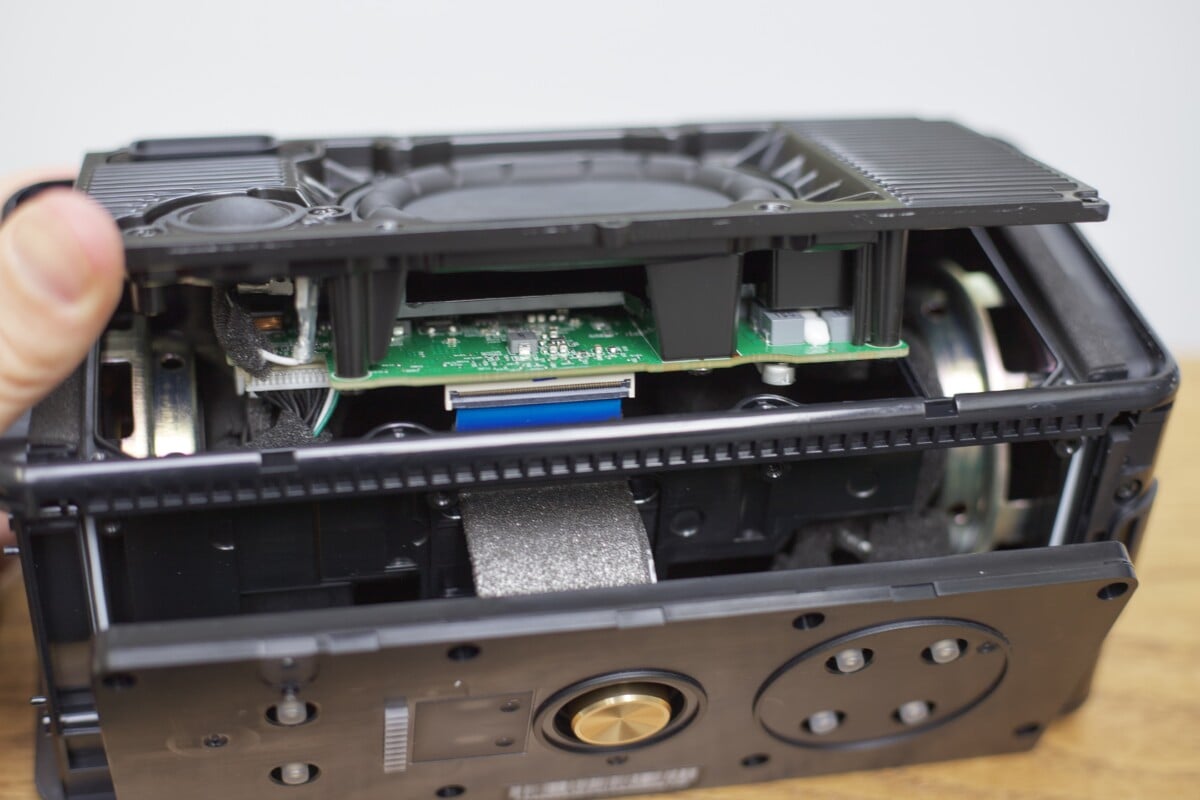
The Marshall has six transducers, installed on the front, rear and sides and protected by solid acoustic grilles. We will discuss later the nature of these transducers, which are installed in an atypical way to diffuse the sound at 360°.
Marshall MiddletonUse and application
Despite its eight hundred kilograms, the Marshall Middleton is not difficult to handle, thanks to its grippy coating and carrying strap. Although it measures approximately 23x10x10 cm, it slips easily into a small backpack. Another positive point, the enclosure is very stable and does not fear shocks.
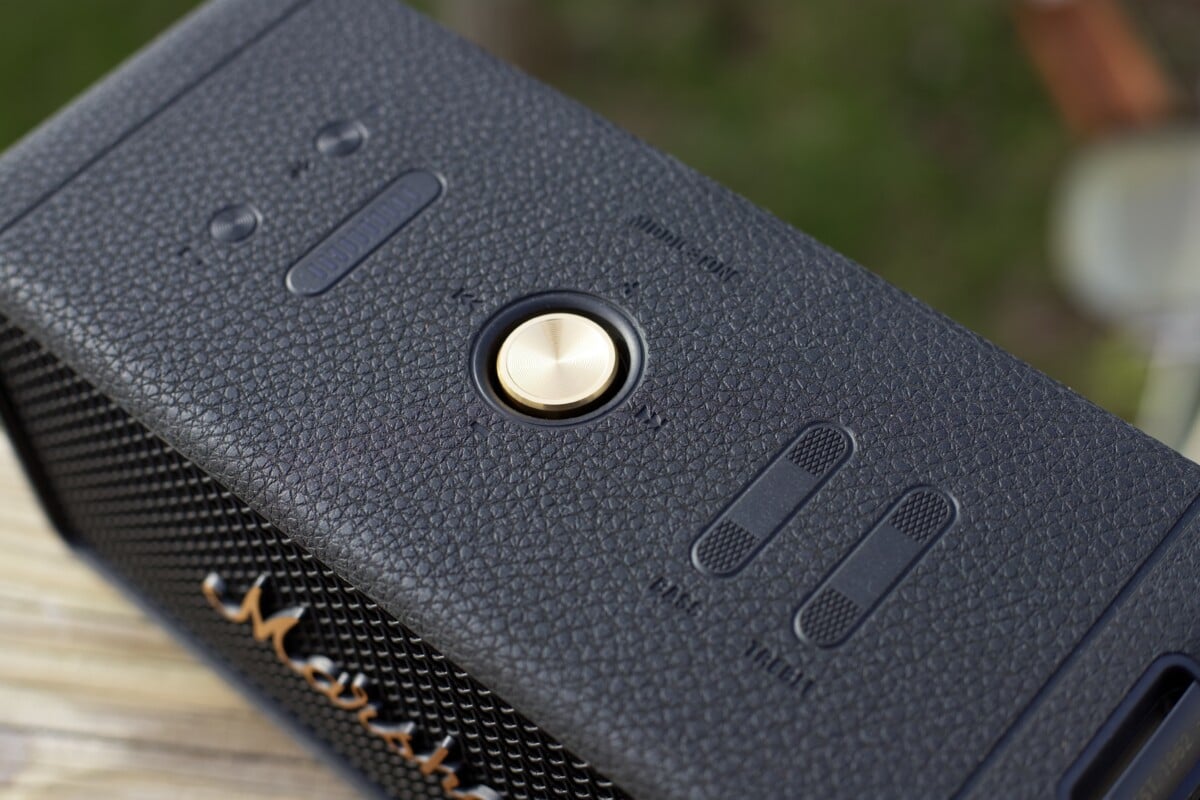
When powered up, the speaker plays a little guitar riff and lights up its LEDs to indicate battery charge status. The control knobs are simple to operate and the ability to change the tone directly from the cabinet is handy.

The Marshall Bluetooth app.

Stack mode allows two speakers to be grouped together for simultaneous distribution.

The tone settings are taken over in the app.
The Marshall Bluetooth app also takes up this equalization function and offers to combine two speakers to broadcast the same musical program.
The Marshall Middleton has a Bluetooth 5.1 controller compatible with the SBC audio codec and multipoint connection. Two sources can thus use the loudspeaker successively, without having to disconnect one to use the other. After verification, Bluetooth reception works well through a thin wall and up to 10 meters away.
Marshall MiddletonAudio
The Marshall Middleton is equipped with six speakers, including two passive radiators. An acoustic solution now common with mobile speakers, which, having a small size, and therefore a low volume of internal air, manage to reproduce more low frequencies thanks to passive radiators. These are driven in their excursions by the active transducers whose performance they improve.
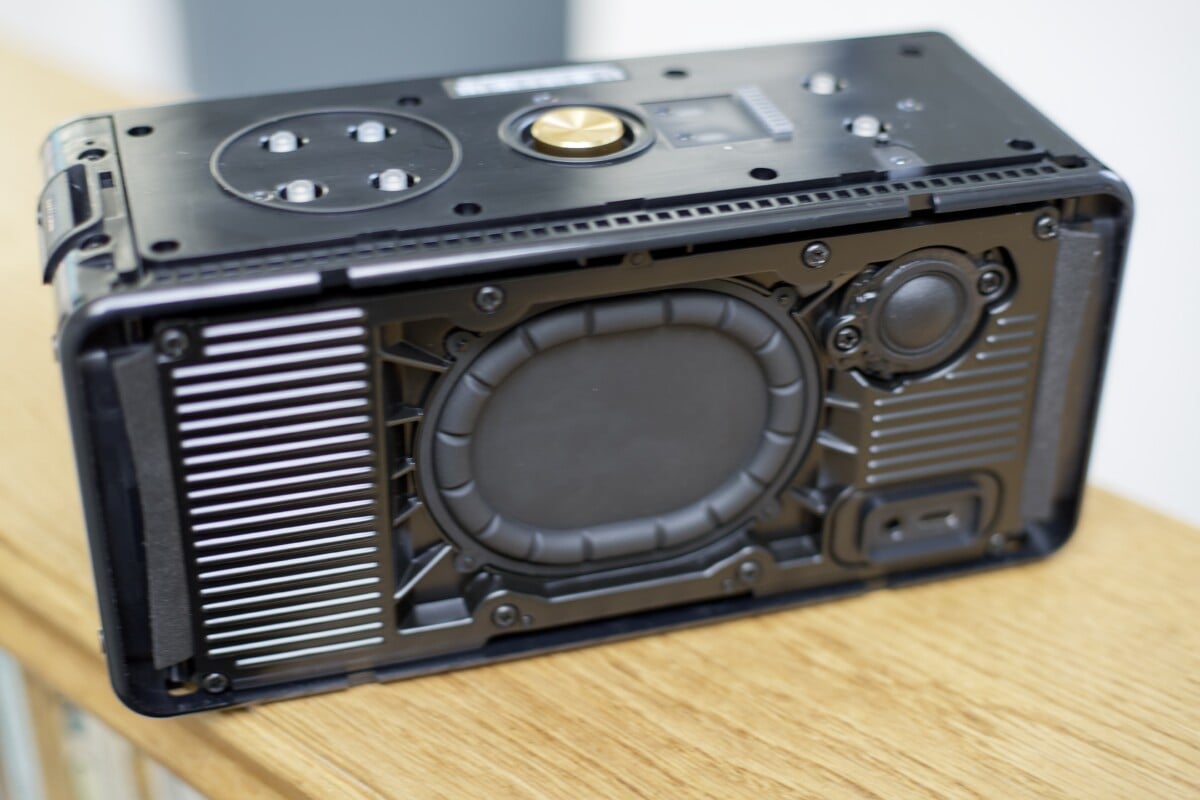
By opening the Middleton, we discover that the main speakers (those that cover the most frequencies) are housed in the sides of the enclosure and thus do not broadcast any sound directly towards the listener, but on the sides. It’s surprising that it has always been good practice in acoustics to direct the transducers towards the listener. Is it problematic to listen to? Not really, because the tweeters are each installed on the front and rear sides of the enclosure. Thus, whether you are placed in front of the Middleton or behind it, you directly perceive a lot of information from the midrange and treble registers.
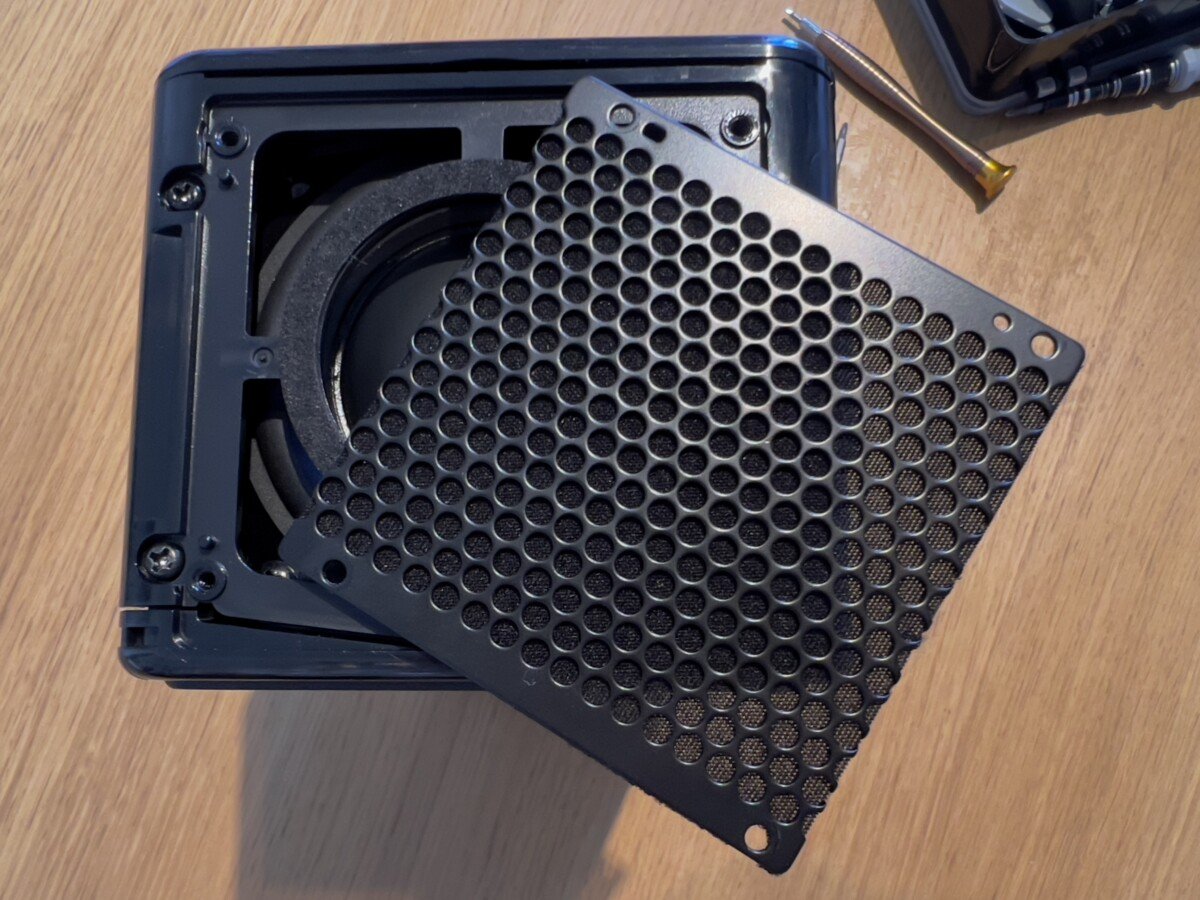
In principle, installing transducers on each side is a good idea, as it provides a circular sound that is very useful outdoors. In the middle of a picnic tablecloth, between two beach towels or lounge chairs, this speaker will deliver the same sound to every listener.
In the Marshall Middleton, we have:
- 2 bass-midrange speakers 8 cm in diameter (with 2×20 W amplification)
- 2 fabric dome tweeters 15 mm in diameter (with 2×10 W amplification)
- 2 passive radiators of 10×8 cm
Signature sound
The Marshall Emberton was tested indoors and outdoors with an iPhone 13 Pro Max from Apple Music.
The sound of the Marshall Middleton is clear and powerful, without harshness or aggressiveness, with a nice spatial openness. The bass, robust and generous gives the listener confidence: the loudspeaker always delivers a balanced and authoritative message. After measurement, we can confirm the frequency response communicated by Marshall, up to 50 Hz in the bass. In reality, this is the speaker’s natural crossover frequency, continuing to play loud at 45Hz, before fading below 40Hz.
As is often the case with this type of compact loudspeaker, Marshall has implemented active low-frequency equalization, the intensity of which decreases as the volume increases. Up to 50% volume, the Middleton maintains its balance, and beyond that, low frequencies are gradually reduced. Thanks to its loudspeakers and its amplification, however, the speaker does not weaken much and remains powerful in the bass.
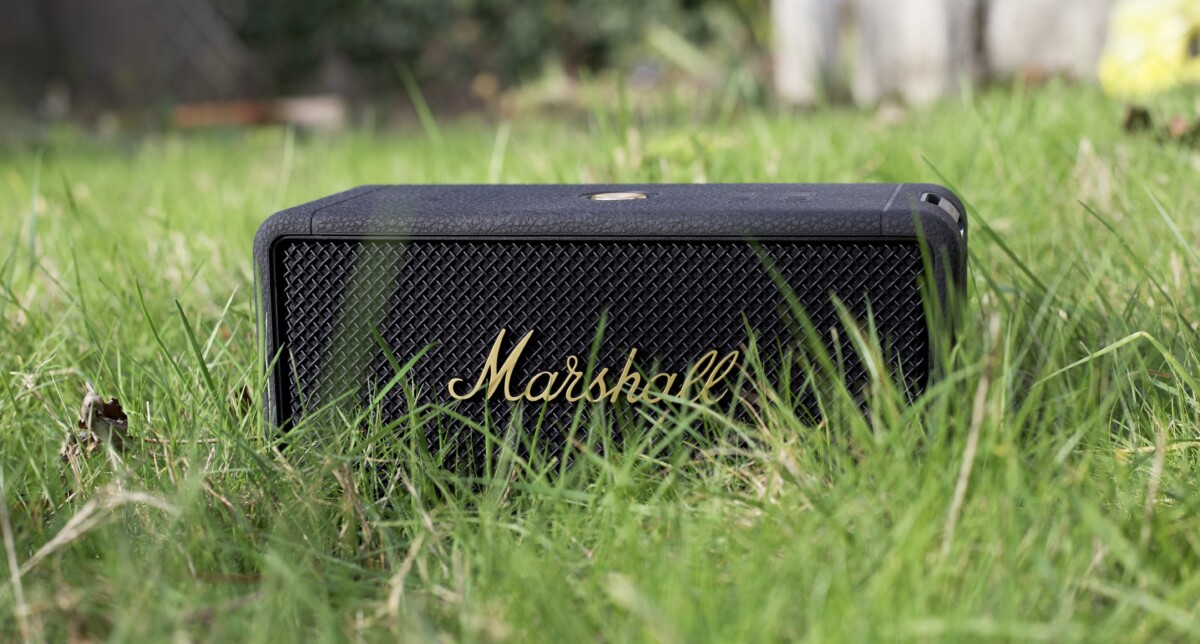
The Marshall signature is there, but it seems to have evolved compared to the manufacturer’s previous models, with a better distributed energy and less centered on the medium. The Middleton is therefore balanced and projects the sound more than it diffuses it at 100% of its volume. It then produces almost 90 decibels of intensity, in the medium frequencies (at 1 meter). With such a volume, the use of the Middleton outdoors is comfortable, even in a busy environment.
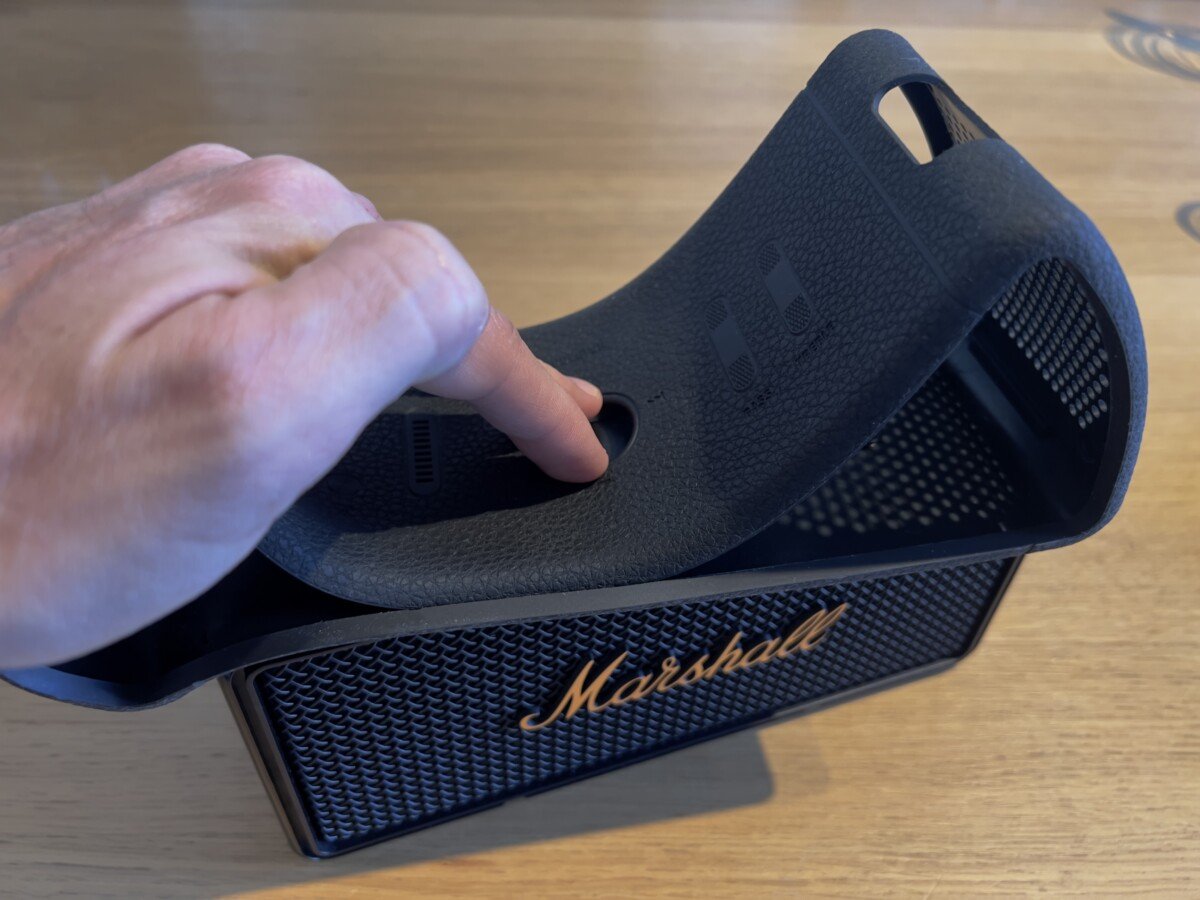
In short, the signature Marshall Middleton is characterized by a deep and solid low end, a suitably defined midrange and an energetic and silky high end. The tone corrections offered by the loudspeaker make it possible to validly adjust the signature.
Scene and dynamic behavior
Given that the Marshall Middleton shoots in all directions, its spatialization is unconventional. However, as the main speakers are housed on the sides, the stereo is suitably marked. Only the high frequencies are not diffused left and right, but in front and behind. It’s really not annoying, and, on the contrary, it gives the sound a nice depth and very little directivity.
On the dynamic side, everything is fine. At low volume, the Middleton plays peacefully but without laziness: it pulsates gently, so to speak, with equal energy across the spectrum. The amplification respects the nuances of the music.
Marshall MiddletonMicrophone
No microphone on the Marshall Middleton, which does not allow audio calls. The speaker is designed exclusively for listening to music.
Marshall MiddletonAutonomy
At 50% volume, the Marshall Middleton lasted just under 11 hours in this test. This is almost half the 20 hours announced by Marshall, who does not, however, specify the volume used for his measurement, or whether the line input was preferred to Bluetooth. To achieve this manufacturer autonomy, it will be necessary to go below 30% of volume, because the amplification then consumes three times less energy according to my measurements. We then obtain a sound volume greater than 70 dB, which is already rather loud.
Marshall MiddletonPrice and release date
The Marshall Middleton is available in black and brass colors for €299. Its direct competitors are the Sony SRS-XG300 – less balanced and generous – and the JBL Xtreme 3, more powerful and incisive. The Middleton plays a little less loudly than the JBL, marks time in terms of dynamics, but its performance/size ratio is better and its 360° distribution is a real asset.
Where to buy the
Marshall Middleton at the best price?
